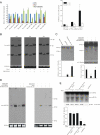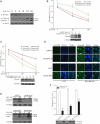Stress induces p38 MAPK-mediated phosphorylation and inhibition of Drosha-dependent cell survival
- PMID: 25699712
- PMCID: PMC4502444
- DOI: 10.1016/j.molcel.2015.01.004
Stress induces p38 MAPK-mediated phosphorylation and inhibition of Drosha-dependent cell survival
Abstract
MicroRNAs (miRNAs) regulate the translational potential of their mRNA targets and control many cellular processes. The key step in canonical miRNA biogenesis is the cleavage of the primary transcripts by the nuclear RNase III enzyme Drosha. Emerging evidence suggests that the miRNA biogenic cascade is tightly controlled. However, little is known whether Drosha is regulated. Here, we show that Drosha is targeted by stress. Under stress, p38 MAPK directly phosphorylates Drosha at its N terminus. This reduces its interaction with DiGeorge syndrome critical region gene 8 and promotes its nuclear export and degradation by calpain. This regulatory mechanism mediates stress-induced inhibition of Drosha function. Reduction of Drosha sensitizes cells to stress and increases death. In contrast, increase in Drosha attenuates stress-induced death. These findings reveal a critical regulatory mechanism by which stress engages p38 MAPK pathway to destabilize Drosha and inhibit Drosha-mediated cellular survival.
Copyright © 2015 Elsevier Inc. All rights reserved.
Figures







Similar articles
-
p38 MAPK-mediated loss of nuclear RNase III enzyme Drosha underlies amyloid beta-induced neuronal stress in Alzheimer's disease.Aging Cell. 2021 Oct;20(10):e13434. doi: 10.1111/acel.13434. Epub 2021 Sep 16. Aging Cell. 2021. PMID: 34528746 Free PMC article.
-
Loss of Drosha underlies dopaminergic neuron toxicity in models of Parkinson's disease.Cell Death Dis. 2018 Jun 7;9(6):693. doi: 10.1038/s41419-018-0716-5. Cell Death Dis. 2018. PMID: 29880811 Free PMC article.
-
Alternative splicing affects the subcellular localization of Drosha.Nucleic Acids Res. 2016 Jun 20;44(11):5330-43. doi: 10.1093/nar/gkw400. Epub 2016 May 16. Nucleic Acids Res. 2016. PMID: 27185895 Free PMC article.
-
Review: Non-canonical role of Drosha ribonuclease III.Int J Biol Macromol. 2023 Dec 31;253(Pt 5):127202. doi: 10.1016/j.ijbiomac.2023.127202. Epub 2023 Oct 2. Int J Biol Macromol. 2023. PMID: 37793530 Review.
-
Autoregulatory mechanisms controlling the Microprocessor.Adv Exp Med Biol. 2010;700:56-66. Adv Exp Med Biol. 2010. PMID: 21627030 Review.
Cited by
-
LRRK2 Contributes to Secondary Brain Injury Through a p38/Drosha Signaling Pathway After Traumatic Brain Injury in Rats.Front Cell Neurosci. 2018 Mar 1;12:51. doi: 10.3389/fncel.2018.00051. eCollection 2018. Front Cell Neurosci. 2018. PMID: 29545743 Free PMC article.
-
The microRNA cluster miR-183/96/182 contributes to long-term memory in a protein phosphatase 1-dependent manner.Nat Commun. 2016 Aug 25;7:12594. doi: 10.1038/ncomms12594. Nat Commun. 2016. PMID: 27558292 Free PMC article.
-
Regulation of microRNA biogenesis and its crosstalk with other cellular pathways.Nat Rev Mol Cell Biol. 2019 Jan;20(1):5-20. doi: 10.1038/s41580-018-0059-1. Nat Rev Mol Cell Biol. 2019. PMID: 30228348 Review.
-
Neuronal activity regulates DROSHA via autophagy in spinal muscular atrophy.Sci Rep. 2018 May 21;8(1):7907. doi: 10.1038/s41598-018-26347-y. Sci Rep. 2018. PMID: 29784949 Free PMC article.
-
An Emerging Role of miRNAs in Neurodegenerative Diseases: Mechanisms and Perspectives on miR146a.Antioxid Redox Signal. 2021 Sep 1;35(7):580-594. doi: 10.1089/ars.2020.8256. Epub 2021 Feb 15. Antioxid Redox Signal. 2021. PMID: 33403895 Free PMC article. Review.
References
-
- Ambros V. MicroRNA pathways in flies and worms: growth, death, fat, stress, and timing. Cell. 2003;113:673–676. - PubMed
-
- Brennecke J, Hipfner DR, Stark A, Russell RB, Cohen SM. bantam encodes a developmentally regulated microRNA that controls cell proliferation and regulates the proapoptotic gene hid in Drosophila. Cell. 2003;113:25–36. - PubMed
-
- Cen H, Mao F, Aronchik I, Fuentes RJ, Firestone GL. DEVD NucView488: a novel class of enzyme substrates for real-time detection of caspase-3 activity in live cells. The FASEB journal : official publication of the Federation of American Societies for Experimental Biology. 2008;22:2243–2252. - PubMed
Publication types
MeSH terms
Substances
Grants and funding
LinkOut - more resources
Full Text Sources
Other Literature Sources
Molecular Biology Databases

